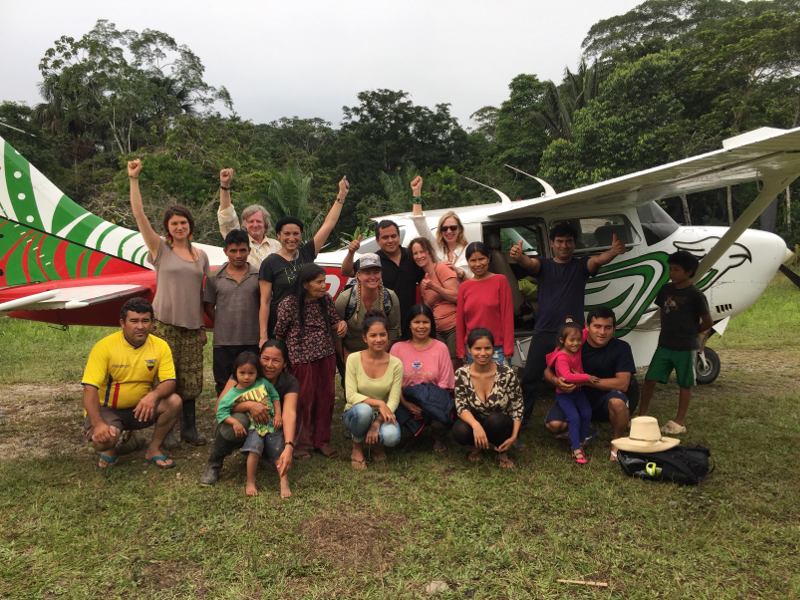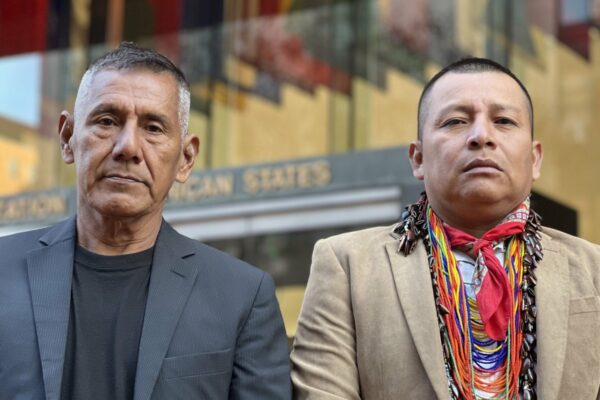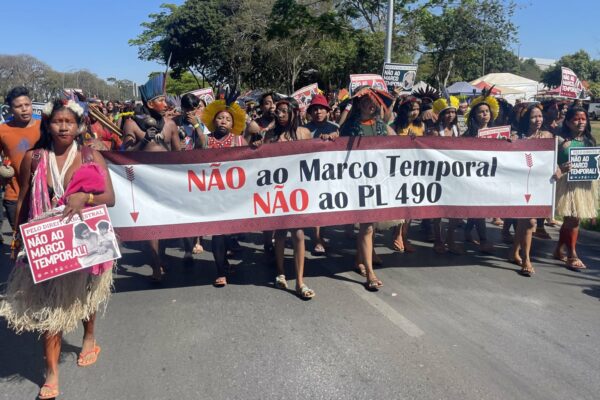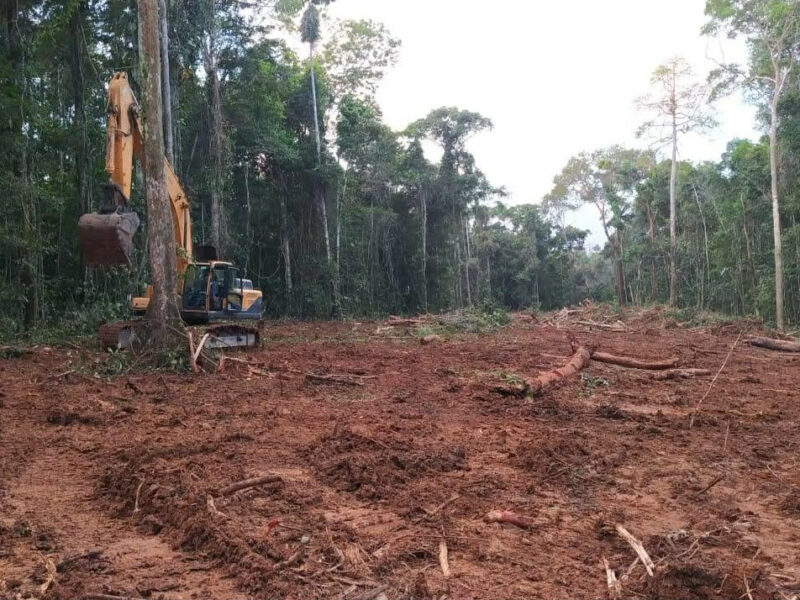Just a few weeks ago, I was in deep in the Amazon visiting our indigenous partners the Sápara and the Kichwa of Sarayaku with a small group of Amazon Watch supporters. Following the troubling start to the new year, it was just what I needed to disconnect from the daily shocks of our political reality and to reconnect to the forces of nature and our partners. I am so grateful for this opportunity and want to share some of my reflections with you on why we rise and resist for the Amazon.
Our first stop was Naku, a newly renovated healing center in the Llanchama community deep in Sápara territory. Imagine waking up to the sounds of hundreds of parrots and oropendolas, participating in healing plant ceremonies and bathing in the river all before breakfast. Imagine taking time to reflect on and share your dreams. Imagine walking through the forest with Manari Ushigua, our friend and the President of the Sápara Nation of Ecuador, who has led his people’s defense of their land and culture from oil drilling, as he explains the uses and properties of countless tropical plants – like mini forest coconuts, cat’s claw, tropical cedar and bromeliads – used as food sources, healing medicines, in construction and for ornamental beauty.
After a few days in Sápara territory, we traveled to the Kichwa territory of Sarayaku. As soon as our small AeroSarayaku plane touched the landing strip, groups of women and children came out to greet us. The men had already gone hunting in preparation for Uyantza, Sarayaku’s biannual festival of abundance. The women were in the midst of preparing copious amounts of chicha, the fermented drink made of manioc that is an essential staple of the Amazonian diet. When they finished, the women gathered and celebrated their work, talking and laughing into the night. The laughter was contagious!
Over the next few days, being in Sarayaku was like living in a matrilineal society. As the men were in the forest, the women also prepared for Uyantza. They gathered manioc; prepared chicha; made and decorated pottery; dyed their hair with “huito,” the cooked seed from which the blue/black dye comes; intricately decorated their faces; and gathered flowers. It was so beautiful and calm – the perfect place to wake up before sunrise to sit around the fire, drink guayusa tea and talk to friends and elders about life and politics in Sarayaku and beyond.
One evening after a journey on the Bobonaza River to visit a giant Kapok tree (a giant canopy tree that the Kichwa believe is a house of spirits and duendes), I asked Patricia Gualinga, a dear friend and the international representative for the governing council of Sarayaku, to speak with us about Sarayaku’s Living Forests. She reminded us that the Kawsak Sacha – the Kichwa term – are vital sacred spaces and territories for the forest spirits and beings. This sacred forest is specifically designated in this way to support the energy, health and life of the indigenous peoples that inhabit the forest. Regular people do not live in the Living Forest, however.
“Only very pure people, like shamans, can go there to be in contact with the spirits and forest beings of trees, rivers, lakes and mountains,” she explained. “People like us live in community, or Runa Kawsay. This is where families live, where we practice daily life, where we ensure food sovereignty and implement our self-government. In Sumak Allpa, or “healthy land,” we protect, conserve and enjoy our clean and healthy forest. This is where we go deep into the forest on vacation.” she said. “In Sacha Runa Yachay, Amazonian cultural and spiritual practices are practiced and embodied including the importance of maintaining ecological balance in order for the spirits and beings of the Living Forest to continue existing.”
While Patricia and I have traveled to many international gatherings together to promote the visionary idea of designating the Living Forests as sacred natural areas free from industrial extraction, truly understanding the sacredness of the Living Forests comes from spending time in the Amazon and with our indigenous partners. I’ve been traveling to the Ecuadorian Amazon since 1995 and every time I visit I am reminded of why I keep returning and why we cannot give up on the Amazon and its peoples. It is my deep love and appreciation for all that the forest and its people offer not only themselves, but for all of us, for our future generations and for our global climate.
While we know that the Amazon is the world’s largest and most bio-diverse tropical rainforest, is home to the world’s largest river, and is a massive carbon sink, indigenous peoples see the Amazon as the heart of the world and oil as the blood of Mother Earth. To extract oil from the heart of the world is to create ecological and spiritual imbalance that the Amazon, our global climate, nor our future generations can afford. This is the message of our time, coming from indigenous peoples across the Americas, from Sarayaku to Standing Rock and beyond. They are standing strong in defense of water, rights and territories and we are proud to stand with them. We are building bridges of unity, not walls of hate. Considering the troubling times we are facing, it is important to hold onto this message from our indigenous partners as we take action in our daily lives and as we rise up in resistance against injustice.
At Amazon Watch we are rising up and resisting against the constant and increasing threats to the Amazon and its people, including the expansion of oil and mineral extraction into Sapara and Kichwa territories and plans to build mega-dams throughout the Amazon. But we also need to ramp up our efforts to challenge the rollbacks on environmental protections and indigenous rights in the Amazon, particularly in Brazil, where we’ve seen a 30% increase in deforestation in the last year, and where things could get much worse in Brazil and Bolivia if “Big Ag” gets its way. We also need to ramp up our efforts to expose the militarization of indigenous territories and the criminalization of indigenous, Amazonian and environmental human rights defenders.
While this all may seem like an uphill battle, right now we have an incredible opportunity to make a difference for the Amazon, indigenous peoples and our global climate with our campaign to End Amazon Crude, which aims to end the refining and consumption of Amazon crude in the United States, ultimately making expansion of the Amazonian oil frontier economically and politically untenable. With 90% of Amazonian crude coming to the U.S. – 60% to California – U.S. consumers have the opportunity to slash demand and market share for this toxic commodity.
I know that we’re all being called to take action right now on so many issues, and while the threats seem endless, it’s important to remember that our voices, plans and actions are more powerful when we are united. We are uniting and we are building a global movement in defense of our rights, democracy and justice. Amazon Watch and our partners are part of this movement and we invite you to join us as we rise up and resist for the Amazon.
“Resistance is more than a slogan – it’s a movement,” says actor, activist and Amazon Watch supporter Mark Ruffalo. And together, we are building this movement. Join us!




























